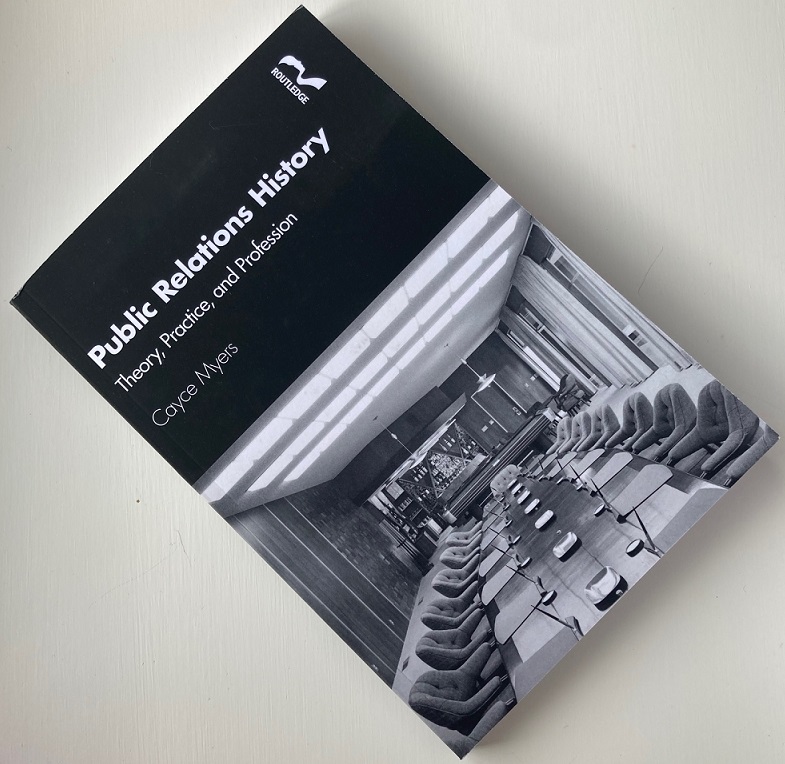Review: Public Relations History

About the author
Richard Bailey Hon FCIPR is editor of PR Academy's PR Place Insights. He teaches and assesses undergraduate, postgraduate and professional students.

Public Relations History: Theory, Practice, and Profession
by Cayce Myers
Routledge, 2021, 171 pages
If, like me, you have been missing the annual summer trip to Bournemouth for the International History of Public Relations Conference, then this new book admirably fills the gap.
It’s an impressive exercise in clarity of thought and brevity of expression. So we have a short history of what is potentially a large subject. Because, as the author notes, almost every form of communication throughout history could, depending on your definition of the field, be considered public relations. The alternative would be a narrow and exclusive history focusing only on the professional institutions or the lives of a self-selecting elite of ‘great white men’ and limited to the past century.
So this is an conceptual overview of the subject rather than an exhaustive treatment such as Scott Cutlip’s 800 page The Unseen Power published in 1994.
What the author does is argue for the importance of studying public relations history.
‘The history of public relations has a direct impact on the field’s view of itself. Public relations’ concern for ethics, debates over definitions of PR practice, the concern over the professionalization of the field, and the profession’s focus on managerial functions are all rooted in public relations history.’ Cayce Myers
He also makes a distinctive case for the importance of political public relations in the development of the wider field (‘public relations development frequently starts with government’). He also argues for a greater historical focus on non-corporate uses of public relations, such as in not-for-profit organisations.
I was intrigued by his examples from the 1770s, when American colonists successfully used public relations techniques to foster anti-British sentiment, ultimately leading to independence. He’d earlier critiqued the prevailing focus on the United States in public relations histories, but how many other nations were created by public relations? The United States is the public relations nation!
Two chapters address the much-discussed overlap between propaganda and public relations, and another looks at the similarities between publicists and press agents (‘the most maligned and misunderstood figure in public relations history is the press agent’).
On the relationship between propaganda and public relations, Myers offers this analysis: ‘Public opinion is, in many ways, the linchpin of public relations practice. The recognition that there is a public opinion, and that it has power, is the core of what public relations practice is about… The question that propaganda raises is, is it appropriate to persuade, influence, or even control public opinion?; can public relations achieve these objectives through any means necessary?’
The brevity is admirable, aided by the use of endnotes rather than academic references. I found myself reading it slowly and carefully, which meant I became aware of several minor errors.
Mistakes are inevitable but unfortunate in a book that’s so scrupulous in its research. So the PRCA is variously called the Public Relations and Communications Association (its current, correct name) and the Public Relations and Communication Association, while at its foundation in 1969 it was the Public Relations Consultants Association. IPRA was founded in 1955, not 1949, and may have been confused by the author with the IPR (now CIPR), founded in 1948. (A later chapter in the book stated most of these names and dates correctly). Bernays was Freud’s nephew, not his cousin. Shelley Spector, founder of the Museum of Public Relations is generously thanked, so it’s a shame she’s called Shelly and Shelley on the same page.
These errors are easily corrected and do take much away from this admirable and intellectual overview.
Perhaps this book’s title is misleading.
Rather than being a public relations history, it’s a book about public relations historiography (or the ‘history of history’, the study of how history is told). This makes it even more appealing to scholars, though perhaps less interesting for the general reader.
Educators will also find the discussion questions at the end of each chapter useful prompts for student seminars (example: ‘Is advocacy of a cause automatically propaganda? Does a speaker have to present all sides of an issue to avoid being labeled as engaging in deceptive communication?’)
The final chapter is called ‘The Future of the History of PR’. This paradoxical phrase only makes sense if you understand that this book is historiography rather than history. ‘It is clear that public relations history has reached a state of maturity where it has an overarching viewpoint and solidified themes. While not monolithic in approach, the current status of public relations history embraces a diversity of theoretical perspectives.’
It’s good to see Tom Watson, who established the International History of Public Relations Conference (IHPRC), widely cited, as is Myers’s doctoral supervisor Karen Russell, though I saw no mention of her IHPRC keynote injunction to ‘Embrace the Embarrassing’. Myers has done it here by rehabilitating entertainment publicists, frequently presented in conventional narratives as belonging solely to the unethical past of public relations.